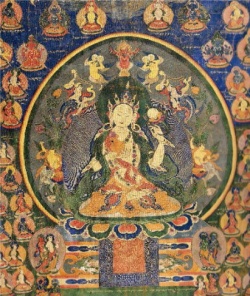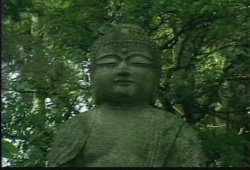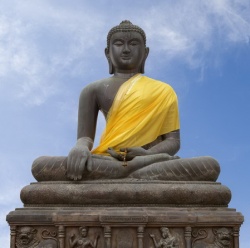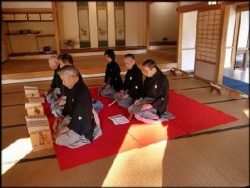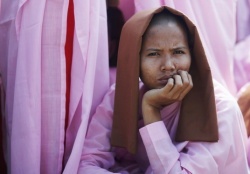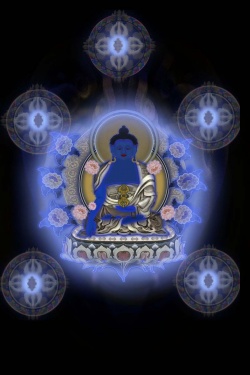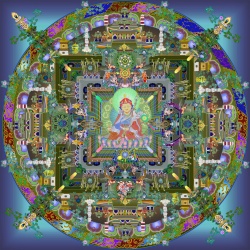Emanations vs. Incarnation
According to the King of Prayers , one of the powers of an enlightened mind is the ability to spontaneously emanate itself through the power of its altruistic intention.
Hence, Manjushri could simultaneously emanate as
Kalarupa,
Yamantaka,
Lama Tsongkhapa,
Dorje Shugden and
countless millions of emanations throughout the 3 realms.
That is emanation
So what is an incarnation? When an attained Lama enters clear light meditation, he would usually emanate into 5 main emanations, which corresponds to body, speech, mind, qualities and activities.
The students of the Lama would search for the mind emanation, which is also known as the incarnation of the high Lama.
That is an incarnation.
Emanations would act independently of each other and may or may not 'manifest' knowledge of concurrent emanations.
Mind emanation presents the characteristics of an enlightened mind
Emanation is an animate or inanimate form manifested by Buddhas or high Bodhisattvas to benefit others.
Nirmanakaya’ in Sanskrit
A gross Form Body of a Buddha that can be seen by ordinary beings.
There are two types – the Supreme Emanation Body and the ordinary Emanation Body.
The first type can be seen only by those who have pure karma, and the second can be seen by anyone.
In general, Buddhas manifest in many different forms and, although the aspect of some of these emanations is mundane, in essence all Buddha’s emanations are fully enlightened beings.
Probably the most important proof of reincarnation is the life of Siddhartha Buddha.
The two greatest spiritual teachers to ever walk this earth were Buddha and Christ.
There are some who would say that Buddha did not teach reincarnation but instead spoke of rebirth.
This is more a difference in semantics. Buddha spoke of having many lives.
This is what reincarnation is
If it is from an infinite source such as all embracing mind of a Buddha which is space like and unobstructed, it can have countless emanations in infinite forms all at one instance.
Reincarnation requires a mode of birth egg womb born, egg born , moisture born, etc in order for the rebirth entity to possess the characteristics of the being specific to that mode of birth.
Egg, to take on human form and characteristics, one need to take rebirth through the womb of a female human.
This solves one of the mysteries of how a bodhisattvas help all sentient beings by able to control their rebirths to be amongst the beings of that particular realm so that they can teach them.
Incarnations can have emanations like in the case of the Tulku Dragpa Gyeltsen who was an incarnation of Duldzin Dragpa Gyaltsän and Panchen Sönam Dragpa and many others in the lineage.
He then emanated as Dorje Shugden as the 5 families emanations ie
Ratna Shugden,
Vairocana Shugden,
Pema Shugden and
Karma Shugden and
the nine beautiful consorts,
8 guide monks and
10 young wrathful agents.
These emanations are His body mandala.
At the same time his incarnations are believed to have continued and is believe to be living among us.
So even incarnations can have emanations.
Emanation is a manifestation of a particular Buddha and it can be a living or inanimate object.
A Buddha's manifestation also have several levels, some cannot be seen and some can be seen by regular beings like myself.
Incarnation on the other hand applies more on existence in the human realm, such as the incarnation lineage of a particular Tulku, or the HHDL, etc.
Although both functions to bring benefit to sentient beings, I believe incarnations are more aligned to bringing the Dharma to sentient beings... while emanations do not only bring the Dharma in general, but have a deeper cause.
To guide living beings along the spiritual path, Dorje Shugden manifests many different aspects.
Sometimes he appears in a peaceful aspect,
sometimes in a wrathful aspect,
sometimes as an ordained person,
sometimes as a lay person,
sometimes as a Bodhisattva,
sometimes as a Hinayanist,
sometimes as a non-Buddhist, and
sometimes even as a non-human.
Since there are so many different emanations of the Buddhas it is difficult to tell who is an emanation and who is not.
The only person we can be certain about is ourself; we know whether we are a sentient being or a Buddha, but we do not know about others.
Each Buddha has the ability to manifest as many emanations as there are living beings.
This ability is necessary because if Buddhas remained in only one form, without any emanations, they would not be able to help all living beings according to their different needs.
Thus, if we refuse to believe that a Buddha can have many different emanations, we are indirectly holding the wrong view of denying that Buddhas can help all living beings. In the Meeting of Father and Son Sutra Buddha Shakyamuni says:
Buddhas manifest in many different aspects such as Brahma, Indra, and sometimes even as a mara or in the aspect of an evil person, but worldly people do not recognize these emanations.
Buddhas can emanate even as inanimate objects.
At one time the great Indian Master, Phadampa Sangye, journeyed to Tibet.
When Milarepa heard of this great Yogi's visit he decided to test his realizations.
He went to the border and waited for Phadampa Sangye to arrive.
When he saw him approaching he transformed himself into a flower to see whether Phadampa Sangye had the clairvoyance to see through his disguise. Phadampa Sangye, however, walked straight past Milarepa, seemingly unaware of his presence.
Milarepa thought to himself
This so-called Yogi has no clairvoyance', whereupon Phadampa Sangye turned round and kicked the flower. ..Get up Milarepa!' he said, and Milarepa, delighted to discover that Phadampa Sangye was a genuinely realized being, sprang up in his usual form to greet him.
